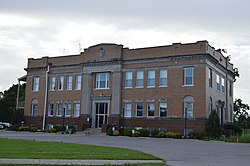2020 census
As of the 2020 census, the county had a population of 5,193. The median age was 46.0 years. 20.5% of residents were under the age of 18 and 22.9% of residents were 65 years of age or older. For every 100 females there were 97.2 males, and for every 100 females age 18 and over there were 97.7 males age 18 and over. [14]
Less than 0.1% of residents lived in urban areas, while 100.0% lived in rural areas. [15]
There were 2,268 households in the county, of which 26.3% had children under the age of 18 living in them. Of all households, 40.1% were married-couple households, 23.0% were households with a male householder and no spouse or partner present, and 32.0% were households with a female householder and no spouse or partner present. About 35.4% of all households were made up of individuals and 17.9% had someone living alone who was 65 years of age or older. [14]
There were 2,831 housing units, of which 19.9% were vacant. Among occupied housing units, 76.0% were owner-occupied and 24.0% were renter-occupied. The homeowner vacancy rate was 1.7% and the rental vacancy rate was 8.6%. [14]
2010 census
As of the 2010 census, there were 6,161 people, 2,642 households, and 1,658 families living in the county. [26] The population density was 30.9 inhabitants per square mile (11.9/km2). There were 3,155 housing units at an average density of 15.8 per square mile (6.1/km2). [5] The racial makeup of the county was 64.4% white, 32.4% black or African American, 0.4% American Indian, 0.2% Asian, 0.7% from other races, and 1.9% from two or more races. Those of Hispanic or Latino origin made up 1.6% of the population. [26] In terms of ancestry, 15.1% were German, 6.8% were Irish, 6.6% were English, and 6.6% were American. [27]
Of the 2,642 households, 27.3% had children under the age of 18 living with them, 43.6% were married couples living together, 14.3% had a female householder with no husband present, 37.2% were non-families, and 33.4% of all households were made up of individuals. The average household size was 2.32 and the average family size was 2.96. The median age was 43.2 years. [26]
The median income for a household in the county was $31,173 and the median income for a family was $39,699. Males had a median income of $36,915 versus $29,007 for females. The per capita income for the county was $18,444. About 16.7% of families and 22.7% of the population were below the poverty line, including 32.0% of those under age 18 and 18.0% of those age 65 or over. [28]




